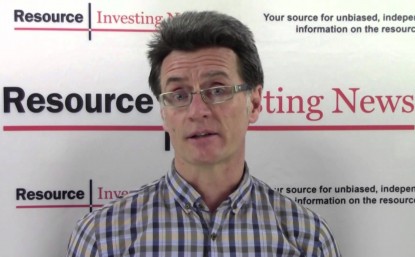
Peter Epstein, CFA, MBA conducted the following interview by phone and email in the week ended July 28th. The views expressed herein are entirely that of Pure Energy Minerals’ management team and Board. To the best of Mr. Epstein’s knowledge, the facts presented by CEO Robert Mintak in this interview are accurate. Mr. Epstein owns no shares of Pure Energy Minerals at this time. Mr. Epstein may or may not acquire shares in the open market at a later date. Please see further disclosures at the bottom of this interview.
Please explain Pure Energy Minerals to readers unfamiliar with your Company?
Pure Energy Minerals [ TSXV: PE; OTC: HMGLF; GR:AHG1 ] is a lithium-brine resource company with a goal of becoming the lowest cost lithium supplier in North America. We are focused on advancing our Clayton Valley Lithium Brine Deposit, “Clayton Valley,” in Nevada. Pure Energy recently released a NI43-101 compliant Inferred Resource Estimate of 816,000 metric tonnes of Lithium Carbonate Equivalent, “LCE” over 8,000 acres across our claim area, inferring a globally significant resources adjacent to the only lithium production facility in North America, Albemarle’s Silver Peak Lithium Mine. [Note: See next question.]
The Company is aligned with global technology partners focused on innovative solutions for lithium brine processing. Based in Vancouver, Pure Energy has a highly experienced management team with backgrounds in finance, exploration, geoscience, lithium processing, permitting and construction. [Please See links to Management Team Below]
On July 28th, Pure Energy filed a NI compliant 43-101 Inferred Resource report (warning 100 pages +) on the Company’s Clayton Valley, Nevada, lithium brine deposit. Please explain its importance.
Yes, this is a key milestone for our Company. The report outlines a NI 43-101 compliant Inferred Resource estimate of 816,000 tonnes of LCE present as easily-extractable brine in two aquifers beneath the Company’s 8,004 acres of claims. We are extremely pleased with this report and believe this deposit to be one of the more important lithium exploration opportunities globally due to its size and location in Nevada.
To advance Clayton Valley to an Inferred Resource, we completed an intensive exploration program including drilling new boreholes to a maximum depth of 970 feet, (296 m). All boreholes drilled encountered lithium-brines, however, they did not encounter the base of the lithium-bearing zones. Thus, the zones that host the brines appear to extend much deeper into the basin and extend laterally, throughout the whole 8,000 acres claim area. As a result, we believe that the Inferred Resource of 816,000 tonnes was estimated using conservative parameters. Pumping tests show that the brine can be sustainably pumped at rates equivalent to those used at Albemarle’s adjacent Silver Peak property.
[NOTE: From the July 28th press release] CEO Mintak states, ‘This initial resource estimate is an important step in validating Clayton Valley and its potential. The estimate is based on an average thickness of just 300 meters. The next drilling stages will test the depth and potential extension of the deposit and test recently discovered zones from our seismic survey. This is a very exciting time for us as we successfully complete key milestones on our resource on-time and on-budget and are able to communicate the tremendous potential of this resource.’
According to your July Corporate Presentation, “lithium brine outpaces hard rock and clay sources on cost, sustainability and permitting with recent technological advancements in processing.” How much of Pure Energy’s story relies on new technology and advancements in processing?
Conventional lithium extraction techniques developed in the 1960’s (at Silver Peak and used globally) involve the use of massive evaporation ponds (4,000+ acres) to concentrate the brines prior to processing. The ponds are expensive to build, only recover ~40%-50% of the available lithium, and require a 12-24 month production (evaporation) cycle, are subject to weather uncertainty and produce large waste piles. In short, evaporation ponds are expensive, unpredictable, harmful, and do not optimize the resource. Although conventional techniques are available, there are several credible organizations committed to developing solutions that have the potential to outperform conventional practice on cost, speed, predictability and sustainability.
Can you please expand upon your prior answer? Emerging lithium players are all turning to enhanced or, “game-changing” lithium extraction processes.
Pure Energy has evaluated a number of lithium extraction technologies. Our research has focused in on two technologies: 1) The LiSX process developed by Israeli mineral processing company Tenova Bateman Technologies, and 2) the lithium extraction technology developed by Korean heavyweight POSCO.
Tenova Bateman’s LiSX technology modifies an existing commercialized solvent extraction process to target lithium, and is capable of producing the various customized high-grade specialty lithium products required by modern industry. This process outpaces its conventional peers because it is environmentally friendly, cost effective, weather-independent, has a process time of <8 hours, and has a much smaller footprint (about 100m by 100m). Tenova Bateman’s process is capable of recovering lithium from waste and by-products, such as spent batteries. Fundamentally, this technology presents the possibility of a viable cradle-to-cradle solution for the use and re-use of U.S. lithium resources.
Pure Energy engaged Tenova Bateman to conduct bench scale testing of their technology using brine produced in Clayton Valley. The results of these tests exceeded our expectations: effectively 100% lithium recovery and production of a very high purity lithium chloride (>99.9%). If viable at commercial scale, this technology could be disruptive and unlock significant value in brine resources. The successful results of this test gets us a step closer towards proving the technology commercially, and Pure Energy intends to continue working with Tenova Bateman to develop the technology for use at Clayton Valley.
The POSCO process is intriguing because it has been proven at pilot scale in Argentina. The development team at POSCO is very credible and of course backed by an entity with a strong balance sheet. So we see value in the application of POSCO’s technology. We have recently shipped brine samples to POSCO for process testing. Ultimately, Pure Energy will complete a technology evaluation that will scrutinize all aspects of these technologies, and perhaps others, and select the best application(s) for our project.
To what extent might Pure Energy’s economics rely on other products besides lithium?
Pure Energy’s primary focus is lithium. There may be other complimentary by-products contained within our Clayton Valley brine, however, these are not currently a factor in our internal preliminary project economics. The Clayton Valley Project will be strongest if the economics prove out based on the lithium resource alone, and that is simple to explain to our shareholders and potential investors. We consider potential by-products and waste recycling as blue-sky opportunities that will be fully considered as the project advances.
What are key corporate developments that investors should watch for this year and next?
Pure Energy is active on a number of fronts and we expect a very busy year ahead. The Company intends to commence exploration work to collect data to support the process of potentially obtaining a NI 43-101 compliant indicated and Measured status report. We will be advancing our technology assessment process with our technology partners. Pure Energy remains very focused on finding a strategic partner to work with to advance the progress of Clayton Valley. The quickest way to possibly commercialize Clayton Valley would be to join with a strategic partner, or to potentially achieve a comprehensive off-take agreement containing development funding and debt financing provisions. Pure Energy is focused on finding the right strategic and/or off-take counter-party that would add maximum value to our project and shareholders.
Do you envision risks to lithium supply over the next 5-10 years? If so, what might they be?
Lithium producers are broadly sophisticated global organizations that have historically performed well to meet global lithium supply. However, demand is increasing substantially, and there are concerns about supply keeping pace, especially for specialty lithium chemicals such as lithium hydroxide.
The biggest risk to mid-term lithium supply is primarily geopolitical. A significant portion of global lithium production is located in countries with high inflation, complex taxation systems, concession limitations, volatile politics and corruption challenges. We are seeing large producers and some developers experiencing headwinds in Chile and Argentina due to some combination of the reasons listed above. For example, in their 2014 year-end earnings statement, FMC forecast a drag on 2015 earnings created by the marco-economic challenges of operating in Argentina. The current annual inflation rate in Argentina hovers around 20%, compared to near 0% in the U.S. In addition, Chile has struggled to execute a clean and transparent concession expansion process. These issues highlight the value of working in stable and supportive jurisdictions such as Nevada.
There are dozens of uses for lithium today, focusing on just two, how does the EV battery opportunity compare to that of the large-scale energy storage opportunity?
Both of these stories hold tremendous promise. Grid storage coupled with renewable energy creates exponential value by smoothing out production and providing electricity when renewables are not available. Growth in this sector is expected to be very healthy at utility, commercial and residential scale. In 2013, California created a mandate pursuant to Bill 2514 calling for 1,325 megawatts of energy storage projects to be procured by 2020, with installation no later than 2024. As of mid-2014, more than 2,000 megawatts of energy storage projects have applied to interconnect with the state’s grid. (California ISO, Energy Storage Interconnection, June 24, 2014.) Most of these projects are lithium storage facilities.
Tesla has also recently announced their residential and commercial stationary storage devices (Powerwall and Powerpacks), which have experienced tremendous uptake by customers with an estimated $800 million in sales in the first week. The energy storage market in 2015 is on pace for a record breaking year, and GTM Research expects the US to deploy 220 MW of energy storage in 2015. To put this in perspective, there is approximately 600-800 kg of lithium carbonate equivalent in every 1 MW of storage capacity.
Lithium-ion battery demand is also being driven by the electrification of the automotive industry, and there is unprecedented investment by the world’s major manufacturers into battery manufacturing facilities in anticipation of the forecast demand. The electric vehicle market continues to present new offerings as electric vehicles transition into the mainstream. The low price of oil could temporarily impact demand for electric vehicles in North America, however, air quality concerns continues to drive the huge market growth in China and to lesser extent, European cities. The Chinese government is pushing to promote cleaner modes of transportation through subsidies and exemptions from restrictions on vehicle registrations.
Can we get a snapshot of your capital structure including cash and debt?
Pure Energy has a very healthy capital structure. We have no debt.
Capital Structure (July 26, 2015)
TSXV: PE; OTC: HMGLF; GR:AHG1
Share Price: C$0.27 Shares on issue: 53.7 million Market Cap: C$14.5 million Debt: Zero
Warrants & Options: 23.6 million 52-week range: C$0.11 to C$0.38 Cash (3/31/15): C$ 1.3 million
Corporate Presentation July 28th press release
Management Bios 2-Page Info Sheet
Pure Energy Minerals TSXV: PE; FWB: AHG; OTC: HMGLF is a speculative, small cap company listed on the Canadian and U.S. markets. An investment in Pure Energy is not appropriate for everyone. Readers and investors are encouraged to do their own due diligence before buying of selling and stocks, especially risky small caps. Due diligence should include consulting with your own investment advisor. The author, Peter Epstein, owns no shares of Pure Energy. Mr. Epstein is not a registered financial advisor. Readers should take this fact into careful consideration.



 Follow us on Twitter
Follow us on Twitter Become our facebook fan
Become our facebook fan











Comments are closed.